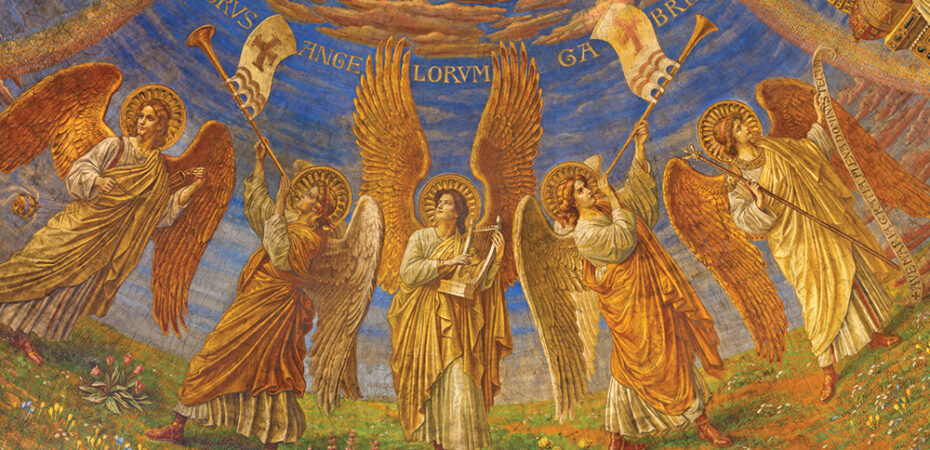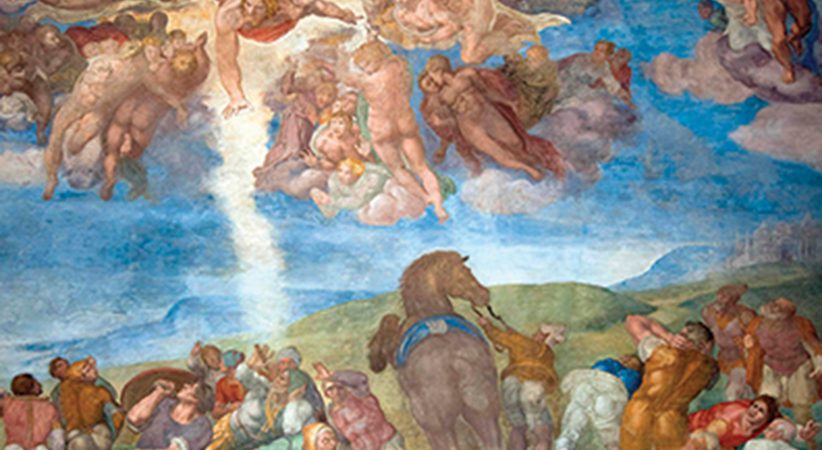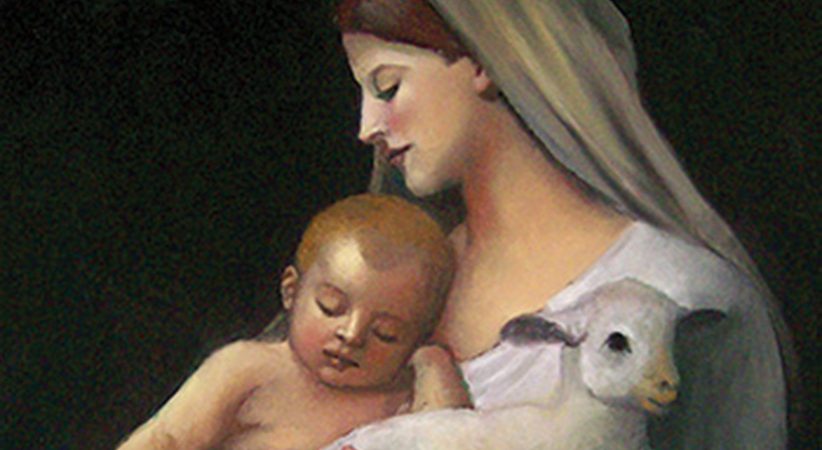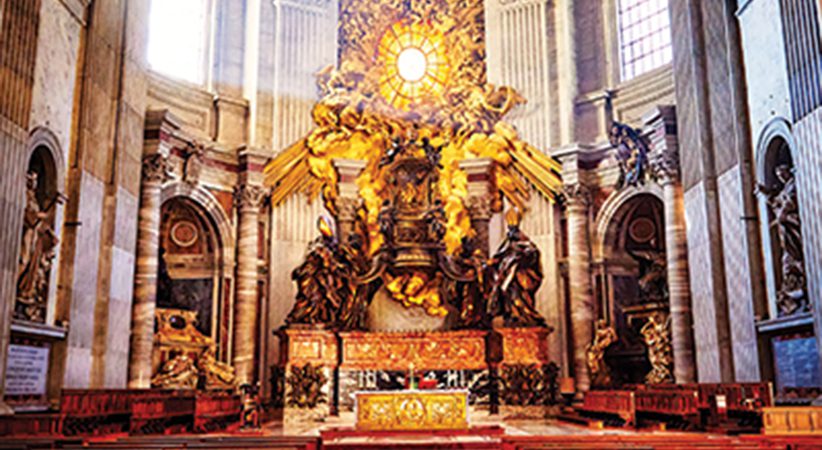Do We Still Need Angels?
What the Scriptures reveal to us about angels
Father Eugene Hensell Comments Off on Do We Still Need Angels?
If you come from a traditional Catholic background one of the prayers you learned as a child was this:
Angel of God, my guardian dear, / to whom God’s love commits me here, / ever this day be at my side, / to light and guard, to rule and guide. / Amen.
This is the famous and still popular prayer to a Guardian Angel. Since Oct. 2 is the feast of the Guardian Angels, this might be a good opportunity to review, perhaps again for the first time, what Scripture, especially the Gospels, reveals to us about angels.
In the Catholic Church, a guardian angel is understood to be a type of angel that is assigned to protect and guide a particular person, group or nation. These angels belong to a larger category of angels in general. However, even though angels are found throughout both the Old Testament and the New Testament, there is no attempt in the Bible to develop them in any systematic way. That being the case, it seems that angels are best understood in terms of their function rather than their nature.
In the Abrahamic Traditions
It seems that angels, as they exist in the Bible, were created by God somewhere in heaven, but how that came about remains a mystery. They are portrayed as purely supernatural spiritual beings. They lack gender, and they appear to be neither male nor female. They do not eat or reproduce. On the other hand, angels possess intelligence, will and moral agency. They are immortal since they do not die. Thanks mostly to the imaginations of artists, angels are often depicted as chubby infants with wings. That image, however, is not found in the Bible. Nevertheless, over the ages, an immense amount of nonsense has grown up around the topic of angels, what they are and what they do. That is not of interest here.
While angels are found in most religions of the world, they primarily appear in the Abrahamic traditions of Judaism, Islam and Christianity. They tend to function as messengers, companions, guardians, guides, overseers or members of the heavenly court. Our focus, however, will be on Christianity and the presence of angels found throughout the Christian Scriptures. The place where we must begin, however, is Judaism, Christianity’s ancestor in faith.
…………………………………………………………………………………………………………………………………………….
ORIGIN OF THE GUARDIAN ANGEL PRAYER
The English translation of the Guardian Angel prayer comes from the Latin Angele Dei prayer. The prayer is often attributed to St. Anselm, a Benedictine monk who lived from 1033 to 1109. But scholars also credit Reginald of Canterbury. In a piece called the “Life of St. Malchus,” Reginald has a verse of a poem that could have been the inspiration for the Angele Dei.
………………………………………………………………………………………………………………………………………………
Judaism is traditionally divided into three principle time periods: pre-exilic Judaism, exilic Judaism and post-exilic Judaism. The exact dates are disputed. Nevertheless, angels appear in different ways in all three periods. Pre-exilic Judaism (before the destruction of Solomon’s temple in 586 B.C.) shows angels with the function of being primarily God’s court attendants. Here their purpose is to praise, adore and do God’s bidding (cf. Ps 148:2). Judaism’s exilic period is known as Second Temple Judaism. The time frame extends from the return of the exiles from Babylon to the rebuilding of the Jerusalem Temple (538-515 B.C.). It ended with the destruction of the Jerusalem Temple in A.D. 70. It is during this period that angelology becomes more fully developed. Some think this is because of the influences of Babylon and Persia experienced during the exile. It is in this period that the most frequently used term for “angel” is the Hebrew word malak, or malak YHWH — “angel,” or “angel of the Lord.”
Roles of Angels
The root meaning is that of “messenger,” one sent from God. Angels act on God’s behalf toward human beings and convey messages from God. Angels who speak on God’s behalf convey divine commands, interpret events and predict happenings. During this exilic period and into the post-exilic time, speculation about angels becomes even more prevalent in the so-called Intertestamental period (516 B.C.-A.D. 70), particularly in apocalyptic literature. Apocalyptic language is important in this matter because it is expressive rather than referential, symbolic rather than factual. Often the material expressed is poetic and mythological. The function of angels fits well into this kind of language.
Much of what we find in the New Testament about angels is derived from the Old Testament and Judaism. The Old Testament view of angels as representatives of the heavenly world and messengers of God is taken over quite literally by the New Testament. The Greek word for angel is angelos, “messenger.”
Angels who serve to interpret past or present events are found in a number of key New Testament incidents, including the birth of Jesus (cf. Lk 2:8-15) and at the empty tomb (cf. Mt 28: 2-3). Predictions of future events by angels include the birth of John the Baptist (cf. Lk 1:5-23) and the birth of Jesus (cf. Lk 1:26-38).
A helpful summary of angels in the New Testament can be found in Jesuit Father John L. McKenzie’s article on “angel” in his “Dictionary of the Bible” (A Touchstone Book, $28). The formatting here is taken from Owen F. Cummings’ recent book, “Angels In Scripture and Tradition” (Paulist Press, $16.95).
– Angels serve as messengers: Mt 1:20; 2:13, 19; Lk 1:11ff., 26ff.; 2:9ff.; Gal 3:19; Heb 1:4ff.; 2:2.
– Angels serve as guardians and protectors: Mt 4:11; 18:10; Mk 1:13; Lk 22:43; Acts 5:19; 12:7.
– Angels serve the divine court: Mt 24:36; Lk 12:8ff.; 15:10.
– Angels serve as companions of Christ as judge: Mt 13:41-49; 16:27; 24:31; Mk 8:38; 13:27; Lk 9:26; 2 Thes 1:7; 1 Tm 5:21.
– Angels bear witness to events of salvation and particularly to Jesus’ resurrection: Mt 28:2; Lk 24:23; Jn 20:12; Acts 8:26; 10:3ff.; 27:23; 1 Cor 4:9.
– Angels are agents of healing and of destruction: Jn 5:4; Acts 12:23.
– Angels offer worship to God: 1 Cor 11:10.
In terms of how angels function in these various settings described above, Cummings’ summary position perhaps says it best. “Angels function in most of the ways described especially in the Old and New Testament texts as symbolic mediations of God’s loving care for humankind,” he writes. “As far as the biblical texts themselves are concerned, these symbolic mediations/angels are undoubtedly real because God’s loving care is the absolute foundation of all reality” (“Angels In Scripture and Tradition,” p. 35).
Let us now return to the image with which we began this reflection: the guardian angels. The Gospel text most often cited for guardian angels is Matthew 18:10. “See that you do not despise one of these little ones, for I say to you that their angels in heaven always look upon the face of my heavenly Father.” Here the “little ones” refers to Jesus’ followers who experienced scorn and persecution. The warning is that “their angels” continually see the face of the Father in heaven. As a result of this warning this verse became the biblical basis for the popular notion of “guardian angels.” It seems that the concept of a guardian angel presumes that those who believe in Jesus (cf. Mt 18:6) are so dear to God that their angelic messengers are continually in God’s presence. Thus one should take care not to treat them with contempt.
There is much debate about the factuality of guardian angels. Many argue that there is actually no proof in the Bible supporting such a reality. Those who believe in guardian angels claim that this belief is based on the Scriptures, but is not directly drawn from it.
What Scripture Reveals
Pope Francis made the following comment about angels: “Without the guidance of angels, men and women who become settled in their ways and put ‘their life on hold’ are in danger of becoming like stagnant water” (Oct. 2, 2018, in his homily during Mass in the Domus Sanctae Marthae). Let us, therefore, ask the question regarding what the Gospels specifically reveal to us about angels. Much of what we find there is taken directly from the Old Testament with little modification.
However, if one examines the infancy narratives and the Resurrection stories of Matthew and Luke a very interesting connection begins to emerge. The primary function of angels remains that of a messenger. They communicate, in a variety of ways, divine messages from God. Closely connected with that function, however, is the task of being guardian and protector. Often the nature of the message from God requires that the messenger be guarded and protected from all harm. It is not much of an overstatement to say that almost all angels are both messengers and guardians. Here are some examples.
Luke 1:5-25, the announcement of the birth of John the Baptist: An angel of the Lord appears to Zechariah during the Temple incense ritual to inform him that his barren wife is going to bear a son. The angel identifies himself as Gabriel and unfolds for Zechariah the important role this child will play in the drama of salvation. The angel’s message follows a typical annunciation pattern. 1) the angel appears; 2) the person is afraid; 3) the angel gives reassurance, announces the birth, tells the child’s name and its meaning, and foretells his great deeds; 4) the person objects; 5) the angel gives a sign.
Luke 1:26-38, the announcement of the birth of Jesus: Here the angel is once again Gabriel. The announcement is made to Mary and follows the same annunciation pattern made to Zechariah. The message indicates that the birth of Jesus will be more important than the birth of John the Baptist. In both of these annunciations, Gabriel, the angel of the Lord, functions as a divine messenger. His message contains a divine presence, which will be fulfilled at the births of John the Baptist and Jesus.
Matthew 1:18-24, the birth of Jesus: Here the main character is Joseph, betrothed to a young girl named Mary. The girl is pregnant but not by Joseph. This looks like a matter of infidelity. Joseph being a just man does not want to expose Mary to public scandal so he decides to quietly divorce her. At this point, the angel of the Lord appears to Joseph in a dream explaining to him the whole situation and instructing him to take Mary as his wife and adopt the son she will bear. Not only does the angel have a message for Joseph, the angel wants to protect Mary. Here the angel of the Lord is primarily a guardian, as well as a messenger.
Matthew 2:13-23, the flight into Egypt and the return from Egypt: Again the angel of the Lord appears to Joseph in a dream and continues to guide the Holy Family away from the dangers of King Herod. Here the function of the angel is guidance and protection.
Matthew 28:1-10, the resurrection of Jesus: The angel of the Lord again plays an important role in informing the women at the time that Jesus has been raised. This monumental event comes accompanied by an earthquake as the angel makes his appearance. There are again elements of an annunciation structure as the angel informs the women what has happened and what they are to do. The angel offers guidance for the women, as well as a remarkable message about the Resurrection.
In the Gospels, angels have various functions. They appear in dreams and communicate divine instructions. They extend God’s protection and care. They are not limited to just one function. They can be both messenger and guardian. Ultimately, angels are manifestations of the presence of God. In a way, they are similar to biblical prophets in that the message they communicate comes from God and not from themselves.
The Catechism of the Catholic Church offers a very brief statement about angels. “The existence of the spiritual, non-corporeal beings that Sacred Scripture usually calls ‘angels’ is a truth of faith. The witness of Scripture is as clear as the unanimity of Tradition” (No. 328).
After the time of the Gospels, there will be an increase in the interest of angels. There will be good angels and bad angels. There will be ongoing debate regarding what an angel really is. But based on what the Gospels reveal about angels, their presence is true while their forms are varied.
FATHER EUGENE HENSELL, OSB, is a monk of St. Meinrad Archabbey in St. Meinrad, Indiana, and an associate professor of Scripture at St. Meinrad Seminary and School of Theology.
……………………………………………………………………………………………………………………………………………….
Books on Angels
 Angels: Our Guardians in Spiritual Battle (OSV, $19.95), by Msgr. Brian Bransfield, describes angels as powerful beings created by God to reflect his light. While we are not aware of them, angels are deeply interested in us. In this book, Msgr. Bransfield teaches us how to recognize the angels present in our lives.
Angels: Our Guardians in Spiritual Battle (OSV, $19.95), by Msgr. Brian Bransfield, describes angels as powerful beings created by God to reflect his light. While we are not aware of them, angels are deeply interested in us. In this book, Msgr. Bransfield teaches us how to recognize the angels present in our lives.
Saint Michael the Archangel (OSV, $14.95), by James F. Day, offers a detailed, thoughtful, well-researched and engaging study into St. Michael. The book’s biblical and historical elements carry readers on a pilgrimage. He explains how St. Michael truly defends us against Satan when we ask.
………………………………………………………………………………………………………………………………………………..





